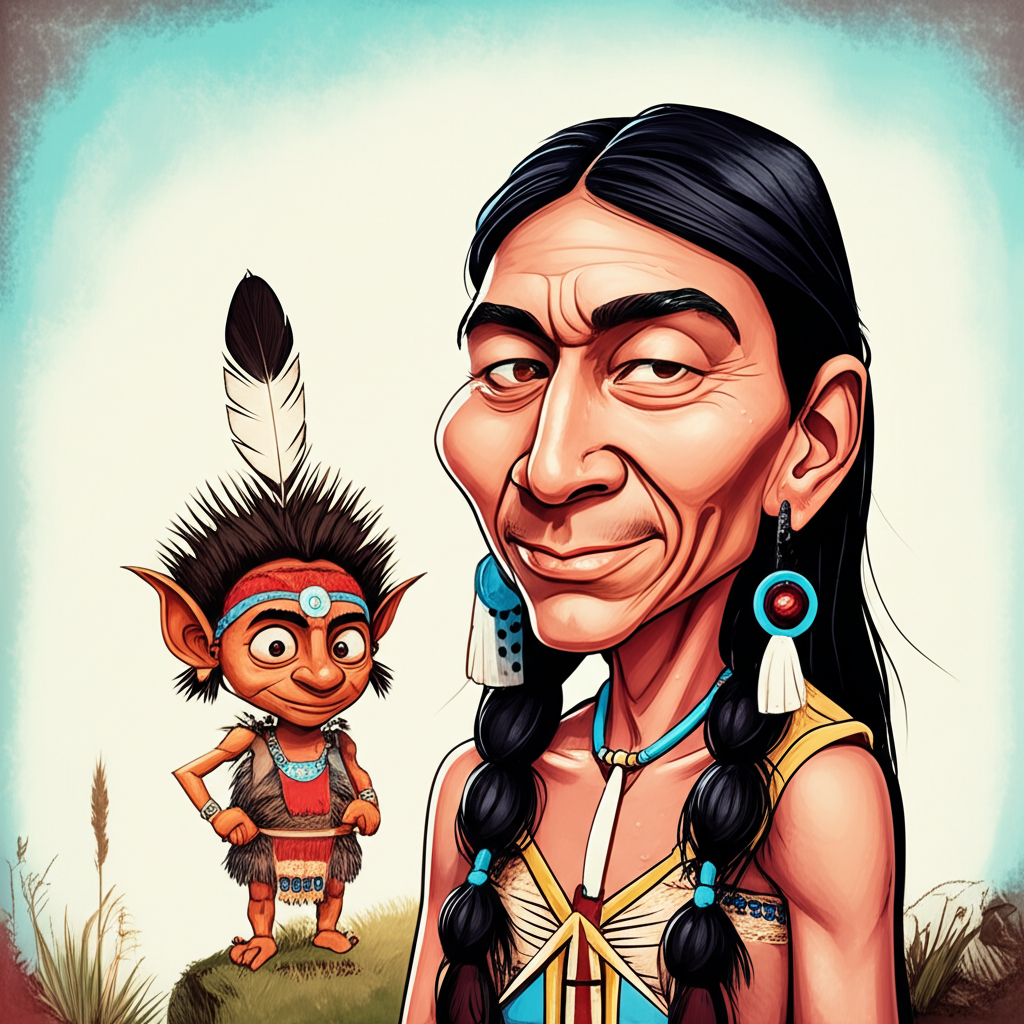
Introduction
Across the vast and windswept Great Plains of North America, and in the shadowed woodlands of the Northeast, whispers of ancient stories linger. These are not tales of verifiable historical events, but rather narratives woven into the cultural fabric of indigenous peoples for generations. Among the most poignant on the Plains is the legend of White Buffalo Calf Woman, a divine messenger bringing sacred knowledge, while in the Northeast, the mischievous Pukwudgie tests the boundaries between the seen and unseen. These stories, passed down through oral tradition, are powerful reflections of how these ancient cultures understood their world, their place within it, and the very essence of existence. It is important to remember that these are traditional stories shared by ancient people, narratives that held deep meaning within their specific cultural context.
Origins and Cultural Background
The story of White Buffalo Calf Woman originates from the Lakota Sioux, a powerful and influential tribe of the Great Plains. Their society, deeply intertwined with the cycles of nature, was predicated on respect for the land, the buffalo, and the spiritual forces that governed their lives. Life on the Plains was often harsh and unforgiving, demanding resilience, adaptability, and a strong sense of community. The buffalo provided sustenance, shelter, and clothing, becoming central to their spiritual and cultural identity. In this environment, myths and legends served as vital tools for transmitting knowledge, moral codes, and a sense of belonging.
The Pukwudgie, on the other hand, belongs to the folklore of various Algonquian-speaking tribes of the Northeastern woodlands, including the Wampanoag and the Narragansett. Their world was one of dense forests, abundant rivers, and a rich diversity of flora and fauna. Living in close proximity to nature, these tribes developed a deep understanding of the interconnectedness of all living things. Their stories often reflected this awareness, exploring themes of balance, respect for the natural world, and the consequences of human actions.
Both the Lakota Sioux and the Algonquian peoples viewed the world as animate, imbued with spirits and unseen forces. These forces could be benevolent or malevolent, and it was crucial to maintain harmony through rituals, respect, and adherence to traditional ways. Myths and legends provided a framework for understanding these forces and navigating the complexities of life.
Character / Creature Description
White Buffalo Calf Woman is depicted as a beautiful and radiant figure, appearing to the Lakota people during a time of hardship and famine. She is often described as wearing a white buffalo robe, a symbol of purity, abundance, and spiritual power. Her arrival is marked by the appearance of a white buffalo calf, a rare and sacred event. Symbolically, she represents hope, renewal, and the restoration of balance. She carries with her a sacred bundle, containing the Chanunpa (sacred pipe), a conduit for communication with the Great Spirit, Wakan Tanka. She teaches the Lakota people the proper ways to pray, perform ceremonies, and live in harmony with the natural world. She is not presented as a god to be worshipped, but rather as a divine messenger bringing essential knowledge and guidance.
In contrast, the Pukwudgie is a more ambiguous figure. Descriptions vary, but they are often depicted as small, humanoid creatures with smooth, gray skin, large noses, and pointed ears. They possess supernatural abilities, including shapeshifting, creating fire, and disappearing at will. Unlike White Buffalo Calf Woman, they are not inherently benevolent. Pukwudgies are known for their trickery and can be dangerous if provoked or disrespected. Symbolically, they represent the untamed aspects of nature, the unpredictable forces that can both help and harm. They serve as a cautionary reminder to respect the boundaries between the human and spirit worlds.
Main Story / Narrative Retelling
A long time ago, when the Lakota people were suffering from a severe famine, two hunters ventured out in search of food. They traveled far and wide, but found nothing but barren land and empty skies. Weary and disheartened, they came across a figure in the distance. As they approached, they saw a beautiful woman dressed in white buffalo skin. She beckoned them closer, her eyes filled with compassion.
One of the hunters, overcome by lust, approached her with impure thoughts. Immediately, a dark cloud enveloped him, and he was reduced to a pile of bones. The other hunter, filled with fear and reverence, knelt before her. The woman smiled gently and told him that she was White Buffalo Calf Woman, sent by Wakan Tanka to help the Lakota people.
She instructed the hunter to return to his village and prepare for her arrival. He did as he was told, and soon, White Buffalo Calf Woman appeared before the entire tribe. She presented them with the Chanunpa, the sacred pipe, and taught them how to use it to pray and communicate with Wakan Tanka. She showed them the proper ways to perform ceremonies and live in harmony with the land. She taught them the importance of respect, generosity, and compassion.
After four days, White Buffalo Calf Woman prepared to leave. As she walked away, she transformed into a white buffalo calf, which then disappeared into the distance. From that day forward, the Lakota people prospered, living in peace and harmony with the natural world, guided by the teachings of White Buffalo Calf Woman.
Meanwhile, in the dark forests of the Northeast, stories of the Pukwudgie were whispered around campfires. One tale tells of a young man who, driven by greed, disrespected a sacred grove of trees. As punishment, the Pukwudgies began to torment him, leading him astray in the forest, setting his belongings on fire, and whispering taunts in his ear. He was driven to the brink of madness before finally repenting and offering a sincere apology to the spirits of the forest. Only then did the Pukwudgies cease their torment, leaving him to find his way back to his village, a wiser and more respectful man.
Symbolism and Meaning
The story of White Buffalo Calf Woman represents the importance of spiritual connection, cultural identity, and the power of renewal. To the Lakota people, she symbolized hope in times of hardship, reminding them that even in the darkest of times, divine intervention is possible. The Chanunpa, the sacred pipe, represented the connection between the human and spirit worlds, emphasizing the importance of prayer and ceremony in maintaining balance and harmony.
The Pukwudgie, on the other hand, served as a reminder of the unpredictable nature of the world and the importance of respecting boundaries. Their trickery and mischievousness highlighted the consequences of greed, disrespect, and disregard for the natural world. They embodied the untamed forces of nature, reminding people that even the smallest creatures can wield significant power.
Modern Perspective
Today, the stories of White Buffalo Calf Woman and the Pukwudgie continue to resonate in literature, movies, and games. White Buffalo Calf Woman often appears as a symbol of indigenous spirituality and cultural preservation. The Pukwudgie, while less widely known, is increasingly featured in fantasy and horror stories, often as a mischievous or malevolent creature. Cultural studies scholars analyze these myths for their insights into indigenous worldviews, social structures, and historical experiences.
Conclusion
The tales of White Buffalo Calf Woman and the Pukwudgie are not declarations of fact, but rich cultural stories that offer a glimpse into the worldviews of ancient peoples. They remind us of the power of storytelling, the importance of cultural heritage, and the enduring human capacity for imagination. As Muslims, we acknowledge that Allah is the sole Creator and Sustainer of the universe. These stories are part of the human experience and reflect the cultures and traditions of people around the world. We study them with respect and a focus on understanding the diversity of human thought and cultural expression.





